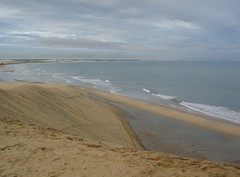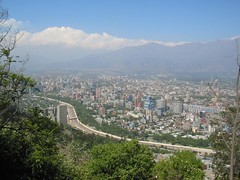A thrilling bike tour, starting from Basel and in a single day you can visit the Black Forest in Germany and Alsace in France, and then close the loop back to Basel along the banks of the Rhine. The route is well signaled and easy, since the gap is not too demanding, but the distance is at least 80 kilometers and can grow depending on route options chosen. The map below provides a route of about 90 km which takes about a day pedaling slowly and stopping to admire the many attractions.
It begins in Basel, in the direction of Riehen, home of the Museum Foundation Beyeler. The urban area continues even after crossing the border into Germany, passing the town of Loerrach. North of Loerrach start several paths, including the Dreiland-Weg. The bicycle path turns straight to the black forest and crosses some beautiful and peaceful villages (Kandern, Liel, Schliengen, Auggen, Neuenburg), with their markets, their railways, the sunny vineyards. Here the Rhine becomes sluggish and you can reach France by crossing one of the bridges for cyclists.
You begin to descend the Rhine towards Basel and discover unforgettable corners of Alsace: the cosmopolitan industrial city of Mulhouse with 1200 houses of the first French settlement of workers and its legendary collection of trains and cars, the Canal du Rhone au Rhin with its boats for tourists, the lone region of Sundgau with its ponds of carps. You return along the Canal de Huningue, that borders the natural reserve of the small Camargue.
The walkway of the three countries (Switzerland, Germany, France) sums up a great trip, which draws a triangle between three states, with their landscapes, their peculiarities, the forest and the river, the extraordinary culinary delights, languages and dialects, road signs and signs of inns, tractors and maize fields, canals and factories, the peasants’ houses with peaked roofs. An opulent feast for palate, eyes, ears, calves and heart, a real journey in the heart of Europe.
Nomadic travel by bicycle
A 60 years old Australian man, in the course of the last year, has covered thousands of kilometers by bicycle along the roads and paths of Latin America, in complete solitude and with the only aid of its legs and the hospitality of the people who met along the way… A nomadic travel along the Americas faced with the right speed, chasing the rhythm of the seasons and the curiosity, without conditionings of sort. An unforgettable nomadic travel!
The synthesis of this experience is in his words: “La importancia de viajar es comprender con tus propios ojos la realidad, es decir observar de una manera crítica, sin que te lo cuente un tercero. Se trata de contemplar sin prejuicios” (the importance of traveling is to experience the reality with your own eyes, that is to observe in a critical way with no one telling you the story. It means contemplate without prejudgments).
From São Luis do Maranhão to Barreirinhas by bicycle
Adventure… From São Luis do Maranhão, with a bicycle of luck I follow the path to the beautiful region of the Lençóis Maranhenses lagoons, breathtaking region where the sky, ocean and beaches are united in one embrace. Arriving in Barreirinhas, unfortunately the bike, already in bad conditions, leaves me and I have to return to São Luis do Maranhão, thanks to some passages and the help of the people met along the way.
Back in São Luis and after meeting again the friends of the last evenings, we are active in the preparation of the carnival, we know the city in all its secrets and small, wonderful details.
Saint Lawrence, patron of the miners
From Antofagasta all roads lead into the heart of the Atacama desert, a trip to a mysterious abyss. Crossing the desert by bus, on foot and partly by bicycle, you come into contact with an incredibly dry earth, a lunar landscape wrought by a tropical and breath taking sun. Even here a few brave people still live, especially because the barren land hides an incredible richness of the subsoil. Along the way are oases of dust and 60 years old american cars, mining towns were abandoned to their infamous faith, swallowed by the sand and the passing of time. Pedro de Valdivia, Maria Elena, and then Quillagua.
The red earth hides, together with the minerals, the countless bodies of those who have come here to die by their own choice (open copper mine of Chuquicamata is the largest in the world), and many by constraint (the Pinochet’s regime jailed in these wastelands dissidents for forced labor). A lasting memory of these tragedies are the graves of Pisagua. The memory of these abuses spread the devotion to Saint Lawrence, considered by Chileans as the patron of the miners and celebrated on August 12 of each year. He hid the material goods of the church under the ground to protect them from the voracity of the Emperor Valerian. Similarly, the Chileans are struggling to maintain control over their natural resources (gold, silver, nickel, molybdenum, sulfur, etc..).
Maria Elena is a town hanging in the wind, the presence of ghosts fills the void of a community hidden underground. Everything disappears in the heat of the afternoon, but even in the evening when the heat loosens its grip, the community does not come alive. The resignation of a life of hardship covered with dusty scrub every house, every object. We stop at a playground where the swings have died of rust and neglect, each mechanism creaks, the children have left these amusements even before their birth.
Santiago de Chile: poetry, recycling, arts
Santiago de Chile, a small hotel for travelers run by an indigenous Mapuche, skyscrapers and crumbling houses. From the hill overlooking the city, as a kind of ordeal, you can enjoy a 360 degree view of the capital city, long and endless. Sometimes hidden behind the clouds, the Andes are majestic and snow-capped, in the background you can see the white paradise of Tres Valles and Valle Nevado, the ski resorts that are located only 50 kilometers from Santiago de Chile. The bustling center takes attention away from the phenomena of creative and marginalized life of the vast majority of the population. In the north of Santiago is located a huge landfill where most of the waste of the city is collected. The people who live there have earned the nickname of moscas, in the evocative dialect of Chile. They brave daily fortune, rising with great agility on each garbage truck that arrives at the landfill and they recover valuable pieces such as iron, copper, aluminum, bicycles and any material that can then be recycled or sold on the black market. Another example of creative adaptation is represented here by Don Ignacio, an intelligent man of about fifty years, who completely dedicated to retrieve pieces of wood, glass and metal at the landfill over the last twenty ones. His only goal, brilliantly achieved, was to build a abusive house with the scraps, equipped with every comfort and a strong and personal sense of aesthetics. The city is alive and looks at arts and poetry. The birth of the murales in Chile as a mass phenomenon, dates back to the 1969, at the time of protests against the Vietnam war, From the port of Valparaíso to Santiago de Chile, a few guys repainted the entire pathway of the protests by stopping at each rock along the road with an old Jeep. The Chilean group of murales is called the brigadas Ramona Parra and was born with the aim of achieving the candidacy of Salvador Allende in the propaganda of 1970. The urban murales are made of symbols and letters. The dove, hands, ears, the stars were a new language that has long been popular in the underground of the night.


